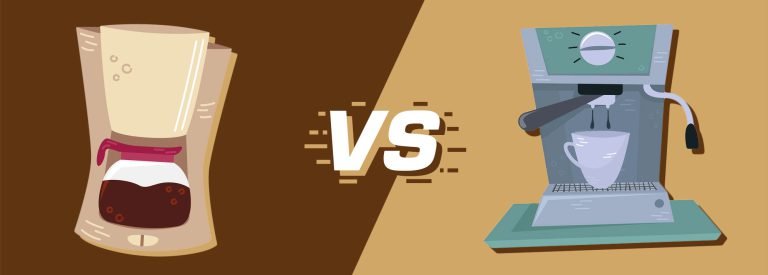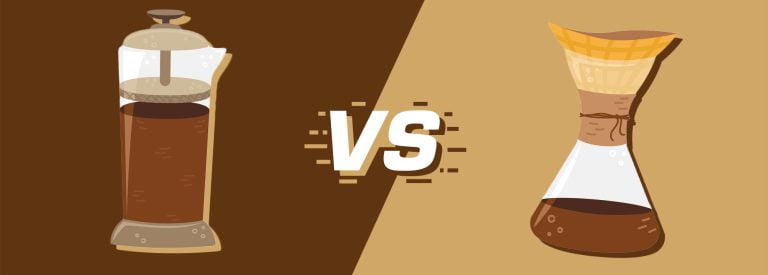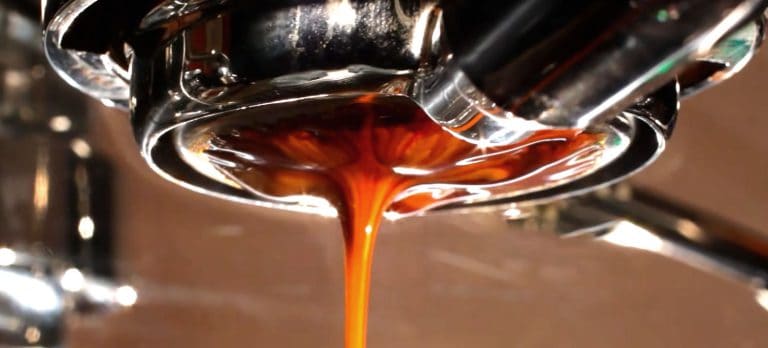Espresso vs Chemex: What Makes Each Brewer Shine?
Both the espresso and Chemex are popular in the world of coffee brewing. One time when I visited a friend who loves making coffee just as I do, he asked me if I’d like an espresso or a Chemex coffee. While I made a quick decision that time, I started wondering: which brewing method really is better?
In this article, I will dive deep into espresso and Chemex to compare their unique characteristics and help you decide which is better suited for your personal preference.
So sit back and let’s get started.
Comparing Espresso & Chemex


Espresso involves forcing hot water through finely-ground coffee at high pressure (9 bars). This creates a concentrated and full-bodied coffee with all the best flavors and oils from the beans extracted, resulting in a visually pleasing crema on top.
On the other hand, there’s Chemex – a manual pour over coffee maker. It involves using a paper filter placed inside an hourglass-shaped glass container while pouring hot water over medium-coarsely ground coffee. The simple design made out of one piece of glass adds an elegant touch to your morning routine (and kitchen counter), as the wooden collar protects your hand from the heat as you pour.
Here are the factors that set the brew methods apart, followed by a detailed comparison of each feature:
| Features | Espresso | Chemex |
|---|---|---|
| Taste & Flavor | Rich, strong flavor with intense punch and crema | Clean, light-bodied with hints of sweetness |
| Strength | Strong intensity | Medium strength |
| Ease of Use | Steep learning curve, requires precision in variables | Easier alternative, simple pouring technique |
| Brewing Speed | Quick (2 minutes), shots in 25-30 seconds | Longer (4-5 minutes) |
| Versatility | Precise brewing method, adjustable recipe | Pour over flexibility, various size options |
| Durability & Portability | Sturdy, not portable | Fragile, compact size but not recommended for travel |
| Sustainability | Commercial models consume more electricity, home models are more sustainable | Eco-friendly glass system, compostable filters |
| Cost | Expensive (ranging from $100 to several thousand dollars) | Affordable (starting from $40), paper filter costs $0.16 per piece |
Taste, Flavor, & Strength
Starting with the taste and strength of the resulting coffee, espresso is undoubtedly a powerhouse. It’s got a rich, strong flavor that packs an intense punch and leaves you feeling awake and focused. The crema on top of the espresso adds additional layering with its smooth texture, but it doesn’t add any flavor. In fact, it is more bitter than the drink itself. Nevertheless, crema on an espresso is great.
On the other hand, Chemex has a different kind of taste profile – clean, light-bodied with hints of sweetness. Using its thicker filter leads to removing oils from coffee beans which results in an even cleaner taste than most brewing methods. It produces coffee with a medium-strength intensity that’s refreshing to the palate.
This category is pretty subjective, but personally, I prefer the full-bodied espresso over the Chemex if I have to decide right now. It’s just that the rich flavors in each cup are hard to contend with, and I find its punch of caffeine too tempting.
But then again, in an hour, I may choose the Chemex for the flavor and benefits of clean black coffee.
Ease of Use
If you’re just starting out, learning to make espresso has quite a steep learning curve. Different factors affect its taste, and you must master precision in variables like the finely-ground coffee, tamping, extraction time, pre-infusion, and the water temperature based on the type of beans you are using.
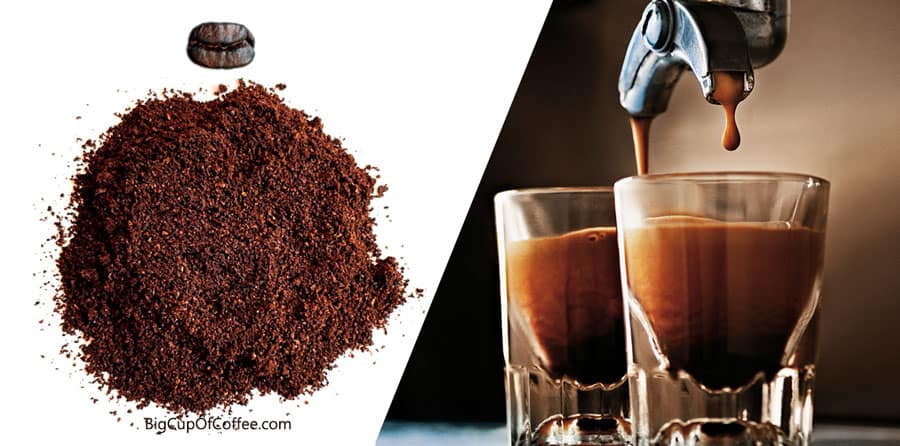
Chemex offers an easier alternative to espresso. You just have to get the timings and pouring technique right, which are not as difficult as they might seem at first. Start with medium-coarse ground coffee and water heated up to 200°F to achieve a smooth-tasting coffee without much hassle.

So between these two brewers, Chemex is the better choice if you’re seeking convenience. If you do commit the time to practice espresso though, pulling shots can be second nature to you.
Brewing Speed
Now onto the brewing speed. You can make espresso fast after you get into it, in just about 2 minutes: grinding, brewing, and cleaning up included. Pulling shots will only take 25 to 30 seconds while regular cleanup of the portafilter and basket is pretty easy. Remember though that espresso machines need deep cleaning occasionally.
Chemex takes longer overall, around 4 to 5 minutes. While other pour over drippers like the V60 only require a quick rinse, Chemex requires more care to clean up due to its fragile glass body.
Overall, if it’s a showdown of brewing speed, espresso wins this race as it could brew your coffee in a few seconds, thanks to the high pressure this method is known for.
Versatility
A brewing method’s versatility is important as you may want to may tweak your brew depending on your mood. Starting off with the espresso, it is a precise brewing method that can be affected by changes in its variables such as grind size, dosage, distribution, tamping pressure, water temperature, and extraction time. You can also alter the espresso recipe to make ristretto and lungo.

Chemex offers some flexibility without sacrificing quality through its pour over brewing technique. You can adjust the grind size, water temperature, and pouring rate to get the right cup.
Now onto the flexibility of their sizes, espresso is pretty limited with one to two shots per pull with each shot equal to an ounce. Chemex has more size options, catering to different needs from a solo cup to bigger batches:
- 3-cup (16 oz)
- 6-cup (30 oz)
- 8-cup (40 oz)
- 10-cup (50 oz)
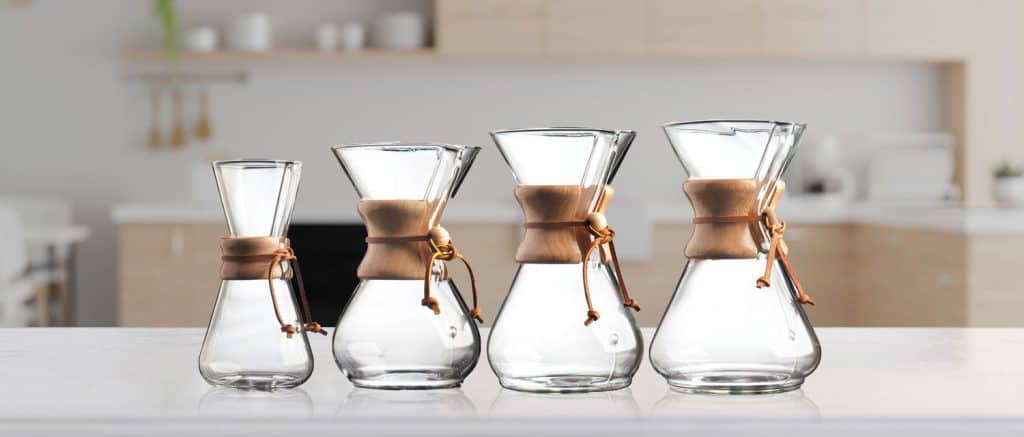
Overall, while espresso can make more concentrated shots of coffee, Chemex takes the win in terms of versatility and capacity flexibility.
Durability and Portability
Home espresso machines’ sturdiness varies based oin their price point. The cheaper machines will not be as well built as the more expensive ones. Commercial-grade versions that you see in cafés are more durable since they are often built with heavy-duty materials. All espresso machines are designed to stay on the counter though, so they’re not really portable.
The Chemex may be made with heat-resistant and shatterproof glass, but it’s still not a very durable option because it can break in one drop. Even if you’re super careful, an accident might happen where you chip or crack the glass. And in terms of portability, Chemex may have a compact size but because of its fragile nature, it is still best to keep it in your kitchen.
So espresso machines are generally more durable than the Chemex, and the Chemex is more space-saving and easy to carry around the kitchen. But because it is made of glass, I still don’t recommend bringing it with you during trips where it might get tossed around.
Sustainability
Making eco-friendly coffee is important to ensure that our favorite beverage does not leave any long-lasting negative effects on our environment.
Looking at espresso machines, commercial-grade models can consume significant amounts of electricity and resources during manufacturing, making them unsuitable for those who want to make sustainable choices in their life. However, home versions like those Breville/Sage espresso makers that use their ThermoJet system, require much less energy. So, if you’re looking for an espresso machine that’s slightly better for the environment, one of these could be a good option.
When it comes to Chemex, its all-glass system with a wooden collar construction makes it quite eco-friendly – especially if you pair it with reusable Chemex filters. If you do opt for their thicker paper filters, know that they are compostable, which helps reduce the carbon footprint of your coffee.
So between espresso and Chemex, the latter is undoubtedly the more eco-friendly choice.
Cost
The gap between the prices of an espresso machine and Chemex is quite wide. Espresso machines are expensive, ranging from $100 to several thousands of dollars depending on the brand and features. But since these use portafilters instead of single-use ones, you don’t have to worry about the recurring cost of buying paper filters.
Chemex is the more affordable choice, with a price that starts from around $40 and goes up to $60. You could save a lot by opting for this brewer but do note that using paper filters can set you back $0.16 per piece (2024)every time you make coffee.
So if you’re quite tight on the budget, then Chemex is the better choice for you. But if you don’t mind paying extra upfront to make high-quality brews, then I also recommend considering an espresso machine.
Espresso and Chemex – Weighing the Pros & Cons
Now that we’ve gotten a closer look at the features of each brewing method, here’s a quick overview of the pros and cons of Espresso and Chemex so you can finally decide which one is for you:
| Brewing Method | Pros | Cons |
|---|---|---|
| Espresso | – Produces highly-concentrated coffee with crema on top – Very fast to produce – Can be used for numerous recipes | – The espresso machine is not portable – Generally expensive – Requires finely ground coffee beans – Dialing in the espresso requires expertise |
| Chemex | – A wide range of sizes and capacity – A clean cup of coffee – Attractive aesthetic | – The glass design can be fragile – Also has a learning curve – Paper filters become a recurring expense |
If you’d like to know how espresso machines fare against other brewing methods, check out my other comparison articles:
You can also read my comparisons between Chemex and these brewers:
Conclusion
There’s a good reason why espresso and Chemex have received quite the following among coffee lovers. Espresso machines are sturdy and they can quickly make you unique crema-crowned brews, while Chemex is versatile, sustainable, and easy to use.
Personally, I prefer espresso as it delivers a potent drink that can be used in many delicious recipes such as latte, cappuccino, and macchiato. But that’s not to say I won’t have a nice pour-over Chemex every now and then.
Now it’s your turn, which method do you like best? Let me know in the comments.


